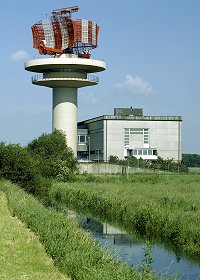SRE-LL
Description of the radar set, tactical-technical characteristics
| Specifications | |
|---|---|
| frequency: | 1250 - 1350 MHz |
| pulse repetition time (PRT): | 2.5 ms |
| pulse repetition frequency (PRF): | 400 Hz (staggered) |
| pulsewidth (τ): | 2.5 µs |
| receive time: | |
| dead time: | |
| peak power: | 5 MW |
| average power: | 9 kW |
| instrumented range: | 200 nautical miles ( |
| km) | |
| range resolution: | < 400 m |
| accuracy: | |
| beamwidth: | 1° |
| hits per scan: | |
| antenna rotation: | 2 - 7.5 rpm |
| MTBCF: | |
| MTTR: | |
SRE-LL
The SRE-LL radar (Surveillance Radar Equipment, twin-L-Band) was developed by AEG Telefunken since 1969, the prototype was installed near Bremen (see Figure). Until 1974 five more series were delivered for a gapless radar coverage in the former western Germany. SRE-LL radars remained operational until the mid-90'ies.
The use of two antennas in back-toback configuration (the so-called “Janus-Design”) gave a better information renewal time for a given revolution rate. The reflector dimensions were 14.5 • 9 m. Both antenna halves generate a Cosecant-squared antenna pattern. The lower edge of the pattern was increased by a Pencil-Beam blanked in the inner range around the radar. The total weight of the rotating parts of the antenna was 60 tons.


